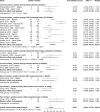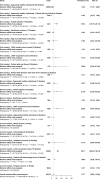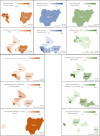Systematic review and meta-analysis of the epidemiology of Lassa virus in humans, rodents and other mammals in sub-Saharan Africa
- PMID: 32845889
- PMCID: PMC7478710
- DOI: 10.1371/journal.pntd.0008589
Systematic review and meta-analysis of the epidemiology of Lassa virus in humans, rodents and other mammals in sub-Saharan Africa
Abstract
Accurate data on the Lassa virus (LASV) human case fatality rate (CFR) and the prevalence of LASV in humans, rodents and other mammals are needed for better planning of actions that will ultimately reduce the burden of LASV infection in sub-Saharan Africa. In this systematic review with meta-analysis, we searched PubMed, Scopus, Africa Journal Online, and African Index Medicus from 1969 to 2020 to obtain studies that reported enough data to calculate LASV infection CFR or prevalence. Study selection, data extraction, and risk of bias assessment were conducted independently. We extracted all measures of current, recent, and past infections with LASV. Prevalence and CFR estimates were pooled using a random-effect meta-analysis. Factors associated with CFR, prevalence, and sources of between-study heterogeneity were determined using subgroup and metaregression analyses. This review was registered with PROSPERO, CRD42020166465. We initially identified 1,399 records and finally retained 109 reports that contributed to 291 prevalence records from 25 countries. The overall CFR was 29.7% (22.3-37.5) in humans. Pooled prevalence of LASV infection was 8.7% (95% confidence interval: 6.8-10.8) in humans, 3.2% (1.9-4.6) in rodents, and 0.7% (0.0-2.3) in other mammals. Subgroup and metaregression analyses revealed a substantial statistical heterogeneity explained by higher prevalence in tissue organs, in case-control, in hospital outbreak, and surveys, in retrospective studies, in urban and hospital setting, in hospitalized patients, and in West African countries. This study suggests that LASV infections is an important cause of death in humans and that LASV are common in humans, rodents and other mammals in sub-Saharan Africa. These estimates highlight disparities between sub-regions, and population risk profiles. Western Africa, and specific key populations were identified as having higher LASV CFR and prevalence, hence, deserving more attention for cost-effective preventive interventions.
Conflict of interest statement
The authors have declared that no competing interests exist.
Figures






References
-
- OIE. OneHealth: OIE—World Organisation for Animal Health. [cited 13 Jun 2020]. Available: https://www.oie.int/en/for-the-media/onehealth/
Publication types
MeSH terms
LinkOut - more resources
Full Text Sources
Miscellaneous

